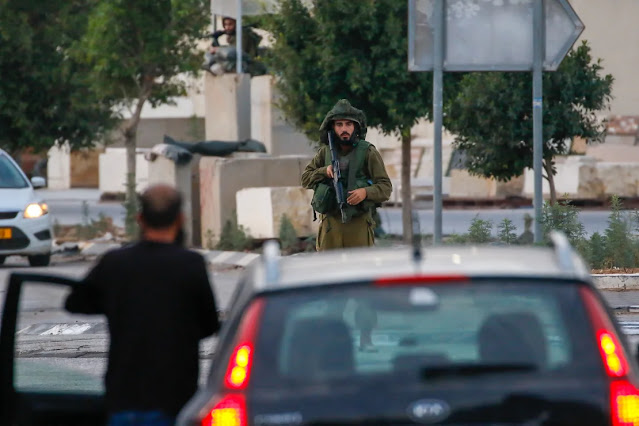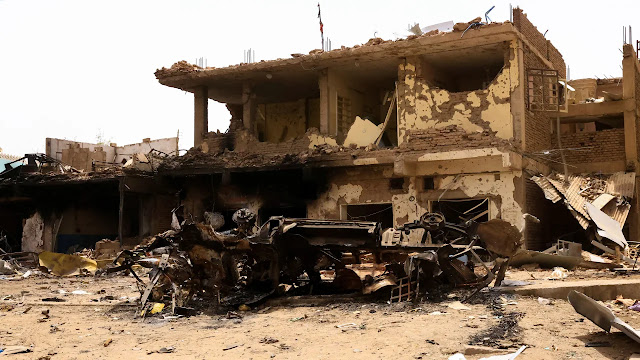Selasa, 14 November 2023
Israel says it is carrying out operation in Gaza’s Al-Shifa Hospital
Senin, 13 November 2023
Doctors race to save newborns as Israel says it’s battling Hamas around Gaza’s largest hospital
Jumat, 10 November 2023
West Bank Palestinians face increasing restrictions and settler violence as Gaza war escalates
Rabu, 08 November 2023
Disturbing videos emerge showing atrocities against African ethnic groups in Darfur
Selasa, 07 November 2023
MrBeast builds 100 wells in Africa, attracting praise – and some criticism
Senin, 06 November 2023
Five graphics that show some of the biggest threats facing the natural world
Sabtu, 04 November 2023
Deadly quake strikes Nepal, toppling homes and killing at least 157 people
At least 157 people have been killed in an earthquake that struck a remote part of northwestern Nepal overnight on Friday and toppled multiple buildings, according to police, as officials warned that the death toll could rise.
The quake measured magnitude 5.6 according to the United States Geological Survey (USGS) and hit some 42 kilometers (about 26 miles) from Jumla, Nepal, in Karnali province. It struck at a comparatively shallow depth of 18 kilometers and the tremors could be felt as far away as India’s capital, New Delhi.
“We are only focused on search and rescue operation right now,” Nepal police spokesperson Kuber Kadayat told CNN Saturday. “That’s why we don’t yet have a proper estimate of collapsed and damaged houses and other infrastructure. There are some villages where an estimated 90% of houses have collapsed.”
According to Kadayat, 157 people have so far been confirmed killed and 170 injured, making Friday’s tremor the deadliest since 2015.
In Jajarkot district, close to the quake’s epicenter, 105 people were confirmed dead and another 55 injured. In nearby Rukum West district, 52 were killed and 85 injured, Kadayat said.
Footage from Reuters showed multiple houses reduced to smashed piles of bricks and timber in Jajarkot.
Earthquakes are common in Nepal, which lies where the Indian and Eurasian tectonic plates meet to create the towering Himalayan mountain range.
At least 9,000 people were killed in 2015 when a 7.8 magnitude earthquake hit, damaging some one million homes and buildings across swathes of the nation and causing $6 billion in damage.
Officials told Reuters that they feared casualties would rise in Friday’s quake because they had not been able to establish contact in the hilly area near the epicenter, some 500 kilometers (300 miles) west of the capital Kathmandu, where tremors were also felt.
“The number of injured could be in the hundreds and the deaths could go up as well,” Jajarkot district official Harish Chandra Sharma told Reuters by phone.
“Many houses have collapsed, many others have developed cracks. Thousands of residents spent the entire night in cold, open grounds because they were too scared to go into the cracked houses as aftershocks struck,” Sharma added.
Jajarkot district has a population of 190,000 with villages scattered in remote hills. Pictures released by AFP news agency showed survivors gathering at Jajarkot’s main hospital.
- https://gamma.app/public/PELISPLUSVer-Saw-X-Pelicula-Completa-Online-en-Espanol-Latino-Saw-6gfw27rat8l1wov
- https://gamma.app/public/PELISPLUSVer-Los-asesinos-de-la-luna-Pelicula-Completa-Online-en--t8wgshb02a6w65l
- https://gamma.app/public/CUEVANA3-VER-Trolls-3-Todos-juntos-2023-Pelicula-completa-en-Espa-i8t3iek2cvoozz1
- https://gamma.app/public/CUEVANA3-VER-Five-Nights-At-Freddys-2023-Pelicula-completa-en-Esp-inl4h07h66yx4so
- https://gamma.app/public/-ALTADEFINIZIONE-2023-Ce-ancora-domani-Streaming-sub-ITA-7rsxj7r12j6atsx
- https://gamma.app/public/-ALTADEFINIZIONE-2023-Five-Nights-At-Freddys-Streaming-sub-ITA-yxcsuqt2tv9i8e8
- https://gamma.app/public/-ALTADEFINIZIONE-2023-Taylor-Swift---The-Eras-Tour-Streaming-sub--227juon7txk3x1x
- https://gamma.app/public/-ALTADEFINIZIONE-2023-Killers-of-the-Flower-Moon-Streaming-sub-IT-uspddy4drm54nwt
- https://gamma.app/public/-ALTADEFINIZIONE-2023-Me-contro-te---Vacanze-in-Transilvania-Stre-ceavkb1p9m4v2jv
- https://gamma.app/public/-ALTADEFINIZIONE-2023-After-Death-Streaming-sub-ITA-v6keaa7asiypt9a
- https://gamma.app/public/-ALTADEFINIZIONE-2023-After-Death-Streaming-sub-ITA-oah3pkx9fyhlchk
- https://gamma.app/public/ALTADEFINIZIONE-2023-Paw-Patrol---Il-Super-Film-Streaming-sub-ITA-l37733x57ra4604
- https://gamma.app/public/KINO-HD-Wochenendrebellen-2023-film-ganzer-deutsch-kostenlos-ansc-tliguf1zvslduw0
- https://gamma.app/public/KINO-HD-Checker-Tobi-und-die-Reise-zu-den-fliegenden-Flussen-2023-c3w61uvyeajvhj7
- https://gamma.app/public/KINO-HD-Trolls-3---Gemeinsam-stark-2023-film-ganzer-deutsch-koste-ygvm8xgzyxuvr52
- https://gamma.app/public/KINO-HD-Paw-Patrol-Der-Mighty-Kinofilm-2023-film-ganzer-deutsch-k-36sxmdj4gh5n4dt
- https://gamma.app/public/KINO-HD-Ein-Fest-furs-Leben-2023-film-ganzer-deutsch-kostenlos-an-hvsc6hoatc1fdnh
- https://gamma.app/public/KINO-HD-Das-fliegende-Klassenzimmer-2023-film-ganzer-deutsch-kost-5szatobny50ozj2
- https://gamma.app/public/KINO-HD-Killers-Of-The-Flower-Moon-2023-film-ganzer-deutsch-koste-8xg049vi51g0wuw
- https://gamma.app/public/KINO-HD-Five-Nights-At-Freddys-2023-film-ganzer-deutsch-kostenlos-02lp9seajf32efz
- https://gamma.app/public/KINO-HD-Die-unlangweiligste-Schule-der-Welt-2023-film-ganzer-deut-y1ozma91uwqvh8w
- https://gamma.app/public/KINO-HD-One-For-The-Road-2023-film-ganzer-deutsch-kostenlos-ansch-35nm7hkfsqlyogc
- https://gamma.app/public/KINO-HD-Napoleon-2023-film-ganzer-deutsch-kostenlos-anschauen-HD-an3izd64cqwi6bw
- https://gamma.app/public/KINO-HD-Ataturk-1881---1919-2023-film-ganzer-deutsch-kostenlos-an-n0evwdk1qz0ncf5
- https://gamma.app/public/KINO-HD-The-Marvels-2023-film-ganzer-deutsch-kostenlos-anschauen--mqsjl2q2ufqdfi8
- https://gamma.app/public/KINO-HD-How-To-Have-Sex-2023-film-ganzer-deutsch-kostenlos-anscha-61m1qiovqtjr5zb
- https://gamma.app/public/KINO-HD-Munch-2023-film-ganzer-deutsch-kostenlos-anschauen-HD-oyfb9gll7bsuvpc
- https://gamma.app/public/KINO-HD-Saw-X-2023-film-ganzer-deutsch-kostenlos-anschauen-HD-y6hifaalnuo3rk0
- https://gamma.app/public/KINO-HD-In-voller-Blute-2023-film-ganzer-deutsch-kostenlos-anscha-mgin5yaro2k23e1
- https://gamma.app/public/KINO-HD-Ein-ganzes-Leben-2023-film-ganzer-deutsch-kostenlos-ansch-chf28rb5aqg0y5r
- https://gamma.app/public/FILMS-VOIR-Les-Trolls-3-2023-Francais-Gratuit-et-VF-Complet-ngak3v0dontwha2
- https://gamma.app/public/FILMS-VOIR-La-Pat-Patrouille-La-Super-Patrouille-Le-Film-2023-Fra-vw1zrq1mlix7ysl
- https://gamma.app/public/FILMS-VOIR-Une-annee-difficile-2023-Francais-Gratuit-et-VF-Comple-4mc2hf51xg39x8i
- https://gamma.app/public/FILMS-VOIR-Second-tour-2023-Francais-Gratuit-et-VF-Complet-v6l3dfnh8ye8t1t
- https://gamma.app/public/FILMS-VOIR-Killers-of-the-Flower-Moon-2023-Francais-Gratuit-et-VF-xmzbqfm8ivtrtm3
- https://gamma.app/public/FILMS-VOIR-Le-Regne-animal-2023-Francais-Gratuit-et-VF-Complet-p2tqnyidlwdvdbr
- https://gamma.app/public/FILMS-VOIR-Le-Garcon-et-le-Heron-2023-Francais-Gratuit-et-VF-Comp-7b77fhgz0ncpee8
- https://gamma.app/public/FILMS-VOIR-Bernadette-2023-Francais-Gratuit-et-VF-Complet-a2g602irwers2jz
- https://gamma.app/public/FILMS-VOIR-LExorciste---Devotion-2023-Francais-Gratuit-et-VF-Comp-yysgxnmcktdd3qo
- https://gamma.app/public/FILMS-VOIR-Five-Nights-At-Freddys-2023-Francais-Gratuit-et-VF-Com-p6tvcnxi1aour70
- https://gamma.app/public/Urmariti-Five-Nights-at-Freddys-Filmul-2023-Online-Subtitrat-in-L-mwj7lfhrl6ef1za
- https://gamma.app/public/Urmariti-Inca-doua-lozuri-2023-Online-Subtitrat-in-Limba-Romana-G-x1ck7uvaqhmlqgh
- https://gamma.app/public/Urmariti-Crimele-din-Osage-County-Bani-insangerati-2023-Online-Su-mai3jb46y9qpe6v
- https://gamma.app/public/Urmariti-Trolii-Se-strange-trupa-2023-Online-Subtitrat-in-Limba-R-u4gy4zpym6n22yf
- https://gamma.app/public/Urmariti-Exorcistul-Cel-care-crede-2023-Online-Subtitrat-in-Limba-by6f1ckpcp9acz4
- https://gamma.app/public/Urmariti-Creatorul-2023-Online-Subtitrat-in-Limba-Romana-Gratuit-fm5iztofzuvdeec
- https://gamma.app/public/Urmariti-saw-x-2023-Online-Subtitrat-in-Limba-Romana-Gratuit-8ab1gyoo8xf1ubc
‘It’s chaos:’ Starving Gazans dig for food, supplies under the rubble
One man carries six jars of cooking oil as he struggles to walk across the rubble. Two little girls run as they each carry stacks of white p...

-
.ดับมาตลอดยุค โซลชาร์-รังนิก แต่โด่งดังในยุค เทน ฮาก ทีเดียว กำลังจะได้รับสัญญาใหม่กับแมนยูฯ ในอีกไม่ช้านี้แล้ว วันจันทร์ที่ 13 กุมภาพันธ์ 2...
-
Libya is racing to bury its dead as bodies pile up in the streets of Derna, the northern coastal city devastated by flooding after a torre...
-
American YouTuber MrBeast’s latest video, in which he says he built 100 wells across Africa, has drawn a complex response online since it wa...





.jpg)


